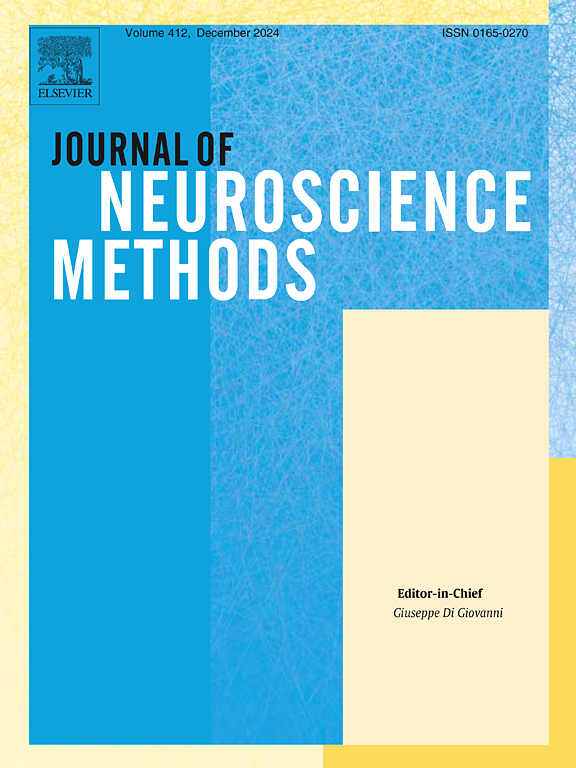人死后脑HDAC活性筛选方法研究。抗精神病药物的概念验证研究。
IF 2.7
4区 医学
Q2 BIOCHEMICAL RESEARCH METHODS
引用次数: 0
摘要
背景:组蛋白去乙酰化酶(HDAC)的密度和活性在不同的脑部疾病中发生改变。抗精神病药物可能调节精神分裂症患者大脑中HDAC的活性。新方法:HDAC活性测定适用于死后人脑样品的酶动力学和HDAC抑制剂(HDACi)筛选研究。结果:优化和表征工作分为几个步骤。表征了在Boc-Lys(Ac)-AMC底物上达到最佳HDAC活性所需的核固体亚细胞分数和总蛋白量。信噪比(1.8)和z评分值(0.82)是检测质量的指标。对非选择性(belinostat、vorinostat、valproic acid)和选择性(apicidin、MS275、roidepsin、tacedinaline和EX527) HDAC的抑制研究表明,优化后的方法检测到I类HDAC活性。所得的IC50值与先前报道的相似,证明了分析的可靠性。我们利用优化后的方法研究了ap对HDAC活性的影响。在死后人脑中对APs的抑制研究,以及长期服用APs的大鼠脑中的酶动力学研究,均未发现对I类HDAC活性的调节。与现有方法的比较:本研究描述了一种可靠且具有成本效益的HDAC活性测定方法的优化,用于死后人脑样本。该方法不依赖于抗体特异性,对酶动力学研究和新的潜在I类HDACi的筛选是有效的。结论:我们优化并表征了一种测定死后人脑样品中HDAC活性的方法。我们没有观察到APs对HDAC活性有任何调节作用。本文章由计算机程序翻译,如有差异,请以英文原文为准。
A method for HDAC activity screening in postmortem human brain. A proof-of-concept study with antipsychotics
Background
Histone deacetylase (HDAC) density and activity are altered in different brain disorders. Antipsychotic drugs (APs) might modulate HDAC activity in brains of schizophrenia subjects.
New method
HDAC activity assay amenable for enzyme kinetics and HDAC inhibitor (HDACi) screening studies in postmortem human brain samples.
Results
The optimization and characterization work involved several steps. The nucleosolic subcellular fraction and total protein amount needed for an optimal HDAC activity on Boc-Lys(Ac)-AMC substrate were characterized. Signal-to-noise ratio (1.8) and Z-score values (0.82) were indicators of the assay quality. Inhibition studies with non-selective (belinostat, vorinostat, valproic acid) and selective (apicidin, MS275, romidepsin, tacedinaline and EX527) HDACis showed that the optimized assay detected class I HDAC activity. The obtained IC50 values were similar to those previously reported, proving the assay reliability.
We used the optimized assay to study the effect of APs on HDAC activity. Inhibition studies with APs in postmortem human brain, together with enzyme kinetic studies in brains of rats chronically treated with APs observed no modulation of class I HDAC activity.
Comparison with existing methods
This study describes the optimization of a reliable and cost efficient HDAC activity assay for its use in postmortem human brain samples. The assay does not depend on antibody specificity and it is valid for enzyme kinetic studies and for the screening of new potential class I HDACis.
Conclusions
We optimized and characterized an assay to measure HDAC activity in postmortem human brain samples. We did not observe any modulatory effect of APs on HDAC activity.
求助全文
通过发布文献求助,成功后即可免费获取论文全文。
去求助
来源期刊

Journal of Neuroscience Methods
医学-神经科学
CiteScore
7.10
自引率
3.30%
发文量
226
审稿时长
52 days
期刊介绍:
The Journal of Neuroscience Methods publishes papers that describe new methods that are specifically for neuroscience research conducted in invertebrates, vertebrates or in man. Major methodological improvements or important refinements of established neuroscience methods are also considered for publication. The Journal''s Scope includes all aspects of contemporary neuroscience research, including anatomical, behavioural, biochemical, cellular, computational, molecular, invasive and non-invasive imaging, optogenetic, and physiological research investigations.
 求助内容:
求助内容: 应助结果提醒方式:
应助结果提醒方式:


